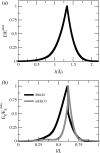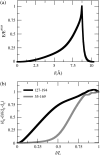Coarse-grained free energy functions for studying protein conformational changes: a double-well network model
- PMID: 17704151
- PMCID: PMC2084241
- DOI: 10.1529/biophysj.107.112060
Coarse-grained free energy functions for studying protein conformational changes: a double-well network model
Abstract
In this work, a double-well network model (DWNM) is presented for generating a coarse-grained free energy function that can be used to study the transition between reference conformational states of a protein molecule. Compared to earlier work that uses a single, multidimensional double-well potential to connect two conformational states, the DWNM uses a set of interconnected double-well potentials for this purpose. The DWNM free energy function has multiple intermediate states and saddle points, and is hence a "rough" free energy landscape. In this implementation of the DWNM, the free energy function is reduced to an elastic-network model representation near the two reference states. The effects of free energy function roughness on the reaction pathways of protein conformational change is demonstrated by applying the DWNM to the conformational changes of two protein systems: the coil-to-helix transition of the DB-loop in G-actin and the open-to-closed transition of adenylate kinase. In both systems, the rough free energy function of the DWNM leads to the identification of distinct minimum free energy paths connecting two conformational states. These results indicate that while the elastic-network model captures the low-frequency vibrational motions of a protein, the roughness in the free energy function introduced by the DWNM can be used to characterize the transition mechanism between protein conformations.
Figures







Similar articles
-
Coarse-grained model for protein folding based on structural profiles.Phys Rev E Stat Nonlin Soft Matter Phys. 2011 Oct;84(4 Pt 1):041934. doi: 10.1103/PhysRevE.84.041934. Epub 2011 Oct 28. Phys Rev E Stat Nonlin Soft Matter Phys. 2011. PMID: 22181202
-
Double-Well Ultra-Coarse-Grained Model to Describe Protein Conformational Transitions.J Chem Theory Comput. 2020 Oct 13;16(10):6678-6689. doi: 10.1021/acs.jctc.0c00551. Epub 2020 Sep 24. J Chem Theory Comput. 2020. PMID: 32926616
-
Directional Force Originating from ATP Hydrolysis Drives the GroEL Conformational Change.Biophys J. 2017 Apr 25;112(8):1561-1570. doi: 10.1016/j.bpj.2017.03.004. Biophys J. 2017. PMID: 28445748 Free PMC article.
-
Stochastic conformational pumping: a mechanism for free-energy transduction by molecules.Annu Rev Biophys. 2011;40:289-313. doi: 10.1146/annurev-biophys-042910-155355. Annu Rev Biophys. 2011. PMID: 21351880 Review.
-
A survey of coarse-grained methods for modeling protein conformational transitions.Curr Opin Struct Biol. 2017 Feb;42:24-30. doi: 10.1016/j.sbi.2016.10.008. Epub 2016 Oct 28. Curr Opin Struct Biol. 2017. PMID: 27810573 Review.
Cited by
-
Conformational heterogeneity within the LID domain mediates substrate binding to Escherichia coli adenylate kinase: function follows fluctuations.Top Curr Chem. 2013;337:95-121. doi: 10.1007/128_2012_410. Top Curr Chem. 2013. PMID: 23543318 Free PMC article. Review.
-
An adaptive weighted ensemble procedure for efficient computation of free energies and first passage rates.J Chem Phys. 2012 Sep 14;137(10):104101. doi: 10.1063/1.4748278. J Chem Phys. 2012. PMID: 22979844 Free PMC article.
-
Allosteric transitions of supramolecular systems explored by network models: application to chaperonin GroEL.PLoS Comput Biol. 2009 Apr;5(4):e1000360. doi: 10.1371/journal.pcbi.1000360. Epub 2009 Apr 17. PLoS Comput Biol. 2009. PMID: 19381265 Free PMC article.
-
Exploring the landscape of model representations.Proc Natl Acad Sci U S A. 2020 Sep 29;117(39):24061-24068. doi: 10.1073/pnas.2000098117. Epub 2020 Sep 14. Proc Natl Acad Sci U S A. 2020. PMID: 32929015 Free PMC article.
-
Exploring the conformational transitions of biomolecular systems using a simple two-state anisotropic network model.PLoS Comput Biol. 2014 Apr 3;10(4):e1003521. doi: 10.1371/journal.pcbi.1003521. eCollection 2014 Apr. PLoS Comput Biol. 2014. PMID: 24699246 Free PMC article.
References
-
- Lodish, H., M. P. Scott, P. Matsudaira, J. Darnell, L. Zipursky, C. A. Kaiser, A. Berk, and M. Krieger. 2003. Molecular Cell Biology. W. H. Freeman, New York.
-
- Ackers, G. K. 1998. Deciphering the molecular code of hemoglobin allostery. Adv. Protein Chem. 51:185–253. - PubMed
-
- Crivici, A., and M. Ikura. 1995. Molecular and structural basis of target recognition by calmodulin. Annu. Rev. Biophys. Biomol. Struct. 24:85–116. - PubMed
Publication types
MeSH terms
Substances
Grants and funding
LinkOut - more resources
Full Text Sources
Miscellaneous

